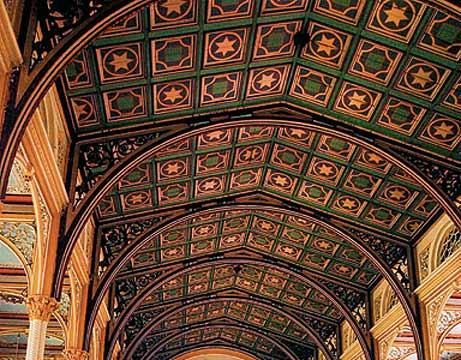Amidst Byculla’s new concrete baubles sits a hidden old gem. Beyond the bumper-to-bumper traffic and just past the bulldozers and half-finished flyover is the oldest museum in the city of Mumbai: the recently restored Dr Bhau Daji Lad Museum, formerly known as the Victoria & Albert Museum, and before that, the Central Museum of Economic Products.
The staid two-storey Palladian building shoulders the expansive grounds of the Jijamata Udyan (earlier the Victoria Zoological Gardens), vying quietly for the attention of day trippers come to pull faces at monkeys. Few know about the existence of this storehouse of Mumbai memories, and fewer still take the time to slow down and breathe in a bit of history here.
The first view of the museum’s Victorian interiors alone is worth way more than the humble
Rs 10 admission fee. Pass the unassuming entrance, click your way through the antique wrought-iron turnstile and feast your eyes upon the magnificent main hall containing the Industrial Arts Gallery and the Bombay School Paintings. The central atrium flaunts a vaulted, jade-green, star-patterned ceiling running the height of the building, with an intricately carved balcony skirting the perimeter of the first floor. Marble chessboard tiles cover the floor, giving the air a hushed coolness that sharply contrasts with the chaos outside. There’s an aura of grandeur about the place, partly due to state-of-the-art retrofitted soft lighting, more so because of the 23.5 carat gold flourishes — a first for a Mumbai heritage building.
Polished wooden cases line the ground floor, showcasing the local design and craftsmanship of the 19th century, an important period in Mumbai’s evolution into a major metropolis. Objets d’art are arranged carefully with trilingual signage and miniature models demonstrate the process of various traditional crafts. Personal favourites in the Industrial Arts Gallery include delicately carved chariots of polished coconut shell, a display of the process of damascening (the art of inserting gold or silver wire onto iron or steel surfaces, a craft that originated in Damascus and arrived in India via Iran and Afghanistan), and a collection of old swords and knives.
At the end of the main hall is a grand staircase that doubles back to the first floor. As you walk up, feeling like royalty, look up to admire the massive gilded chandelier that’s an expansive tangle of leaves and creepers. Upstairs is the Kamalnayan Bajaj Mumbai Gallery, containing an exhibit of the people, lifestyle and geography of 19th-century Mumbai, which make it the cultural melting pot that it is today. You’ll be reminded that before Bombay, Mumbai was called Heptanesia — the ancient Roman name for ‘seven islands’ — and if you’re a local, try to find your neighbourhood on the topographical model of the original archipelago.
Smile at the charming display of the ‘Peoples of Bombay’, where stereotyped models of Bhatias, Boras, Khojas, Parsees, Pathans, Kolis, Sindhis, Sikhs, Baniyas, Marathas and more live happily together in a single display case. Drink in the detail of the model villages replicating 19th-century rural life: two men smoking a chillum, a pair of women laughing in exasperation at the antics of a child, a washerwoman frozen mid-swing as she whirls a wet sari, a villager gently petting a calf. At the far end of the gallery is a collection of fascinating seals used to decorate the body with ash and natural dyes, and there’s even a rare glass plate negative collection of maps, lithographs, watercolours and photographs showing the Mumbai of yesteryears, with its gracious old bungalows, wide, tree-lined, traffic-free streets and unobstructed views of the sea.
The museum’s history goes back to the 1840s, when the East India Company came to then Bombay. A collector named Dr Buist created the Central Museum of Economic Products, which grew to become the Central Museum of Natural History, Economy, Geology, Industry and Arts, with Lord Elphinstone, Governor of the Bombay Presidency, as one of its early patrons, and Sir George Birdwood as one of its first curators. The growth and development of the museum was aided by many prominent Indians, including Sir Jamsetjee Jeejeebhoy, Framji Nusserwanji and Jagannath Shankar-sheth. More actively involved was Ramkrishna Vitthal Lad — better known as Bhau Daji Lad — who had the idea of erecting a new building for the collection and naming it in honour of the Queen Empress of India and the Prince Consort. The museum opened to the public on May 2, 1872, as the Victoria & Albert Museum, and was renamed the Dr Bhau Daji Lad Museum in 1975.
Over time, the museum fell into a state of dereliction and in 2003, a public-private partnership was formed between the Municipal Corporation of Greater Mumbai, the Jamnalal Bajaj Foundation and the Indian National Trust of Art and Cultural Heritage for the complete restoration of the building and its collection. Some 3,500 museum objects have been researched and restored, and the building and surrounding gardens returned to their majestic condition, earning the museum the prestigious UNESCO 2005 Asia-Pacific Award of Excellence for Conservation. A souvenir shop and café are scheduled to open soon, so visitors can take a break between peering at glass display cases. Stop by not just to see the collection, but to collect your thoughts, take a break from the pace of the city and remember how the Mumbaikars you know got here in the first place.
Information
Dr Bhau Daji Lad Museum, Rani Bagh, 91/A Dr Babasaheb Ambedkar Road, Byculla East, Mumbai, 022-23731234, www.mumbaicitymuseum.org. Visiting hours: 10am-5.30pm, closed on Wednesdays.




